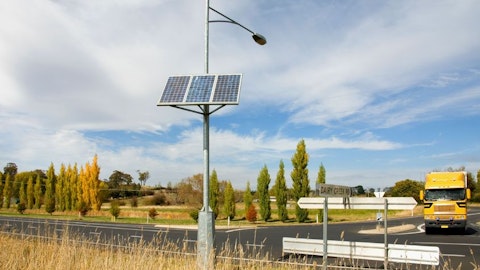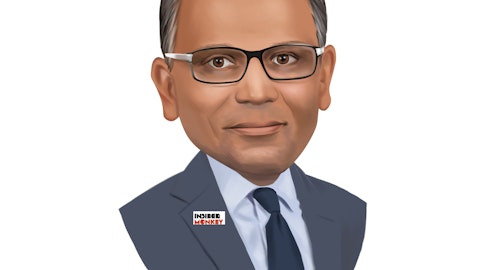Robert Hope: Thank you.
Greg Ebel: Thank you.
Operator: The next question is from Ben Pham with BMO. Your line is open.
Ben Pham: Thanks. Good morning. And can you comment on what was driving the strong mainline volumes during the quarter and then the flow-through to rail exports?
Colin Gruending: Hey Ben, it’s Colin. Yes, thanks for the question. The mainline is super resilient. I think you have proven that over and over and over for decades. Speaking to the quarter, supply has been building. I think maybe that’s been quietly lost in the equation here. So, we have seen supply quietly grow or significantly apportioned during the last couple of the months to prove that point out. Keep in mind, we are doing everything we can to move every barrel we can. We are incentivized to do so to win-win for Enbridge and customers. And therefore, some of that spilled over into rail exports, right, to clear the market. The market is backwardated, so producers want to monetize their product quickly and inventories are kind of average historically speaking.
So, there is still a lot of demand pull utilizations or high refineries from activity and also demand pull there from a dearth of foreign imports. So, I think most of the stars are aligned to support mainline volumes here. And I think you will see this in our late November guidance when we put segment guidance out. I think we are going to see strong liquids EBITDA forecasted for ‘24 on the back of what we were just talking about, Ben. So, don’t see a lot of TMX offload. I think that concept is being oversimplified generally. And I think we are going to see pretty robust volumes in ‘24 as well.
Ben Pham: Okay. Thanks for that Colin. And maybe on the balance sheet, could you update us remaining hybrid capacity room. And given reinvestment program, are you able to share what’s the key driver of initiating that? And how early or how late could you have to make the decision?
Greg Ebel: So, I think on the hybrid, I think the reason we said we had in the range of $4 billion to $6 billion of hybrid capacity. We saw us do about $3.5 billion, $3.6 billion of that right after the announcement. So, we have got some capacity there as we go through it. And sorry, the last comment was on the DRIP. Yes. I mean I think we will consider as we talked about all the options that we have whether that be asset sales more hybrids as you just talked about, the fact that ATM or DRIP will assess that. We haven’t activated it as we speak yet. It’s something we will consider as we move through the year at our capital needs.
Ben Pham: Can I maybe follow-up on that, but let’s say you have initiated the DRIP starting ’24. And you see a quick calculation that doesn’t meet the 25%. But if you push it into 2025, it can meet it. Is there opportunity for now in your discussions of agencies and your funding plan that could work or you need to fulfill everything by the end of 2024? Does that question make sense, yes?
Greg Ebel: Yes. I mean I think we have had really good conversations around the fact that we have committed as we have to the equity markets and to our fixed income investors that we will finance this appropriately. We will get the projects in by the end of 2024, and we will do what we have to do from a balance sheet perspective to make sure that we are in good shape entering ‘25. I think ‘25 is really a year that they are most interested in because that’s what will have all the EBITDA. And so we have got some time to do this, Ben. Remember also that there is lots of different options we have as we move through this. And we will see which is most beneficial to our shareholders and our bondholders as we move through that.
Colin Gruending: Yes. I think you could – let’s see how the other pieces go, we are highly confident in our ability as we have talked about, given historics on recycling. And then as Pat said, you have got the other capabilities and then you look at whether you need to drive the AGM.
Ben Pham: Got it. Thank you.
Operator: Our final question is from Brian Reynolds with UBS. Your line is open.
Brian Reynolds: Hi. Maybe to follow-up on some of the capital allocation questions, perhaps through the lens of how transformational M&A is going to impact some of the return of capital opportunities over the near-term. Can you just update us on the dividend per share outlook of 3% to 5% as we think about 2024. Is that maintained, or could we effectively see Enbridge optimize long-term shareholder value by supporting the balance sheet as it executes some of these funding needs over the near-term? Thanks.
Greg Ebel: Yes. Absolutely. Look, I think we can do more than one thing at one point in time. And I think we have proven that historically by staying in that 4.5x to 5x on the debt to EBITDA and the balance sheet structure as well as return capital to shareholders. And the best way to do that is through dividend growth. And as we have said, we expect to grow the dividend consistent with our DCF. You have seen us do that over time, and I think you can expect to continue to see that. But I guess I would hedge a little bit from, yes, we will lay all that out for you in our guidance for next year. But I – we are very comfortable with where we are on dividend payout and where we are on the balance sheet. And that is all driven by the fact we have deeply reduced any risk of the business by setting up utility type structures in all of our businesses.
So, we think that’s the right structure. It’s a bit unique than other folks. But and you see that even this quarter, some companies have G&P and have moved around and they have seen valuations change from a G&P perspective because you have got volume risk and commodity risk directly or indirectly. We don’t have that. Virtually, none of it. We got a little slug of DCP left. But instead, you have got a very risk resilient and reduced entity over the last several years. And again, we think that allows us to both do what we have been able to do on the balance sheet very comfortably and return shareholders’ capital through dividend growth.
Brian Reynolds: Great. Thanks. Appreciate that. And as a quick follow-up, the realized toll seem to be much higher than the posted toll for the quarter. So, can you just help us understand the drivers there? And as we think about the mainline pooling settlement pushed from Q2 to Q4 for October – from October, anything to read into that? And just to confirm, is there anything that can effectively change between what was announced and what will be final? Thanks.
Colin Gruending: Yes, it’s Colin. Maybe the latter point first. Yes. No, we are working with industry to fully paper the settlement agreement from May, it’s unchanged. I wouldn’t read much into it. It takes time and there is also other things that we been working on other applications and filings from others. But it’s trending valuation [ph] of that filed before year-end. I think on the performance during the quarter, I think it’s all of the above, volumes, toll costs, everything. So, we are managing that asset as industry has incentivized us to do so. And I think you should expect more of the same.




